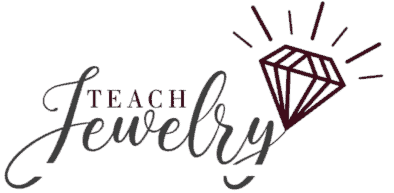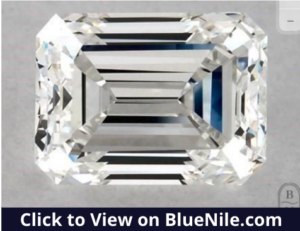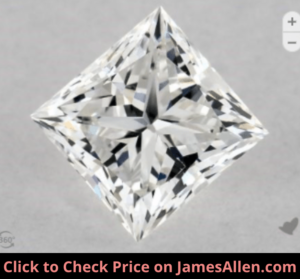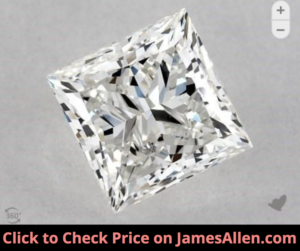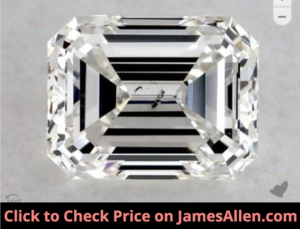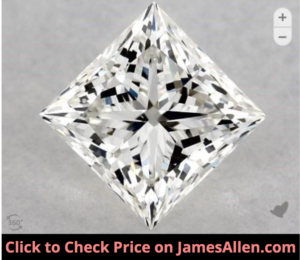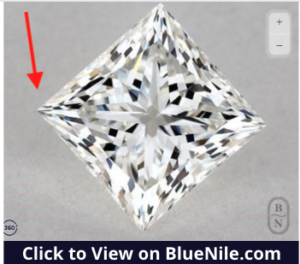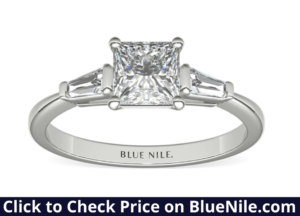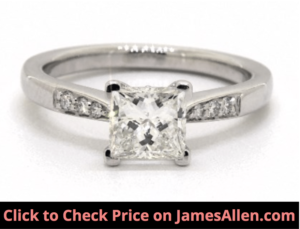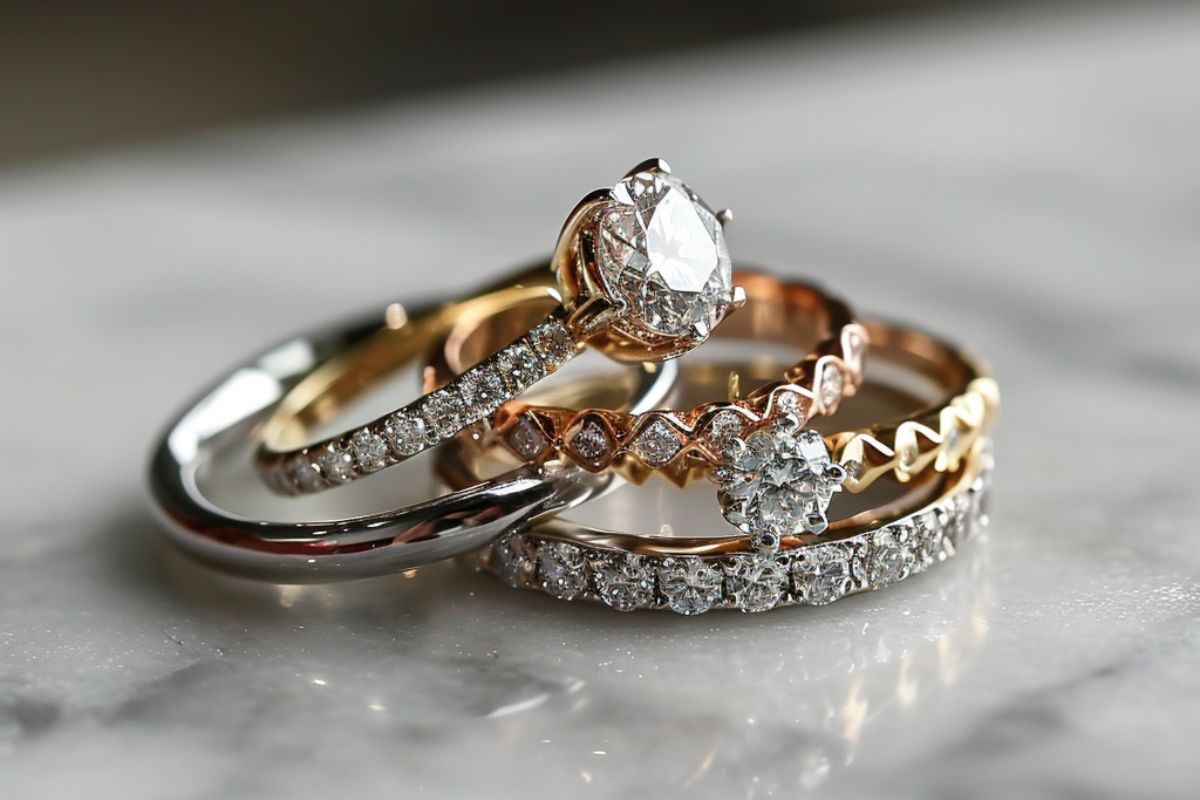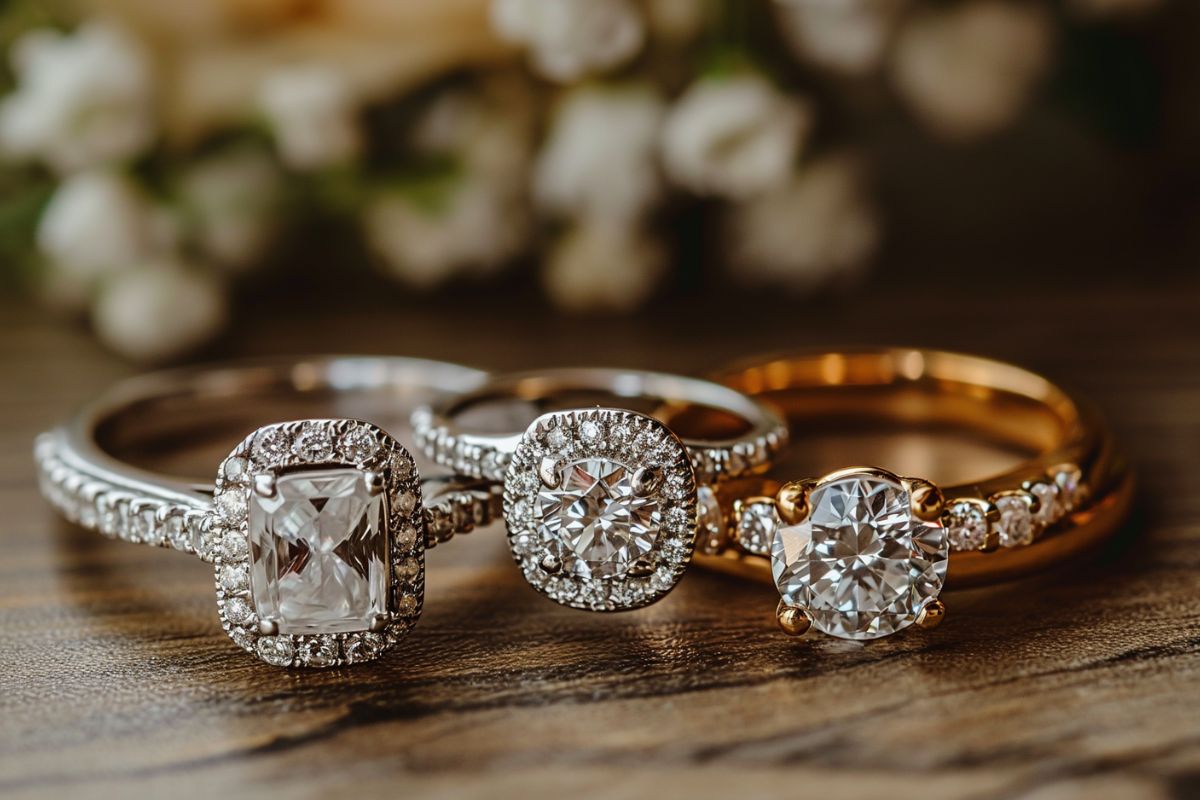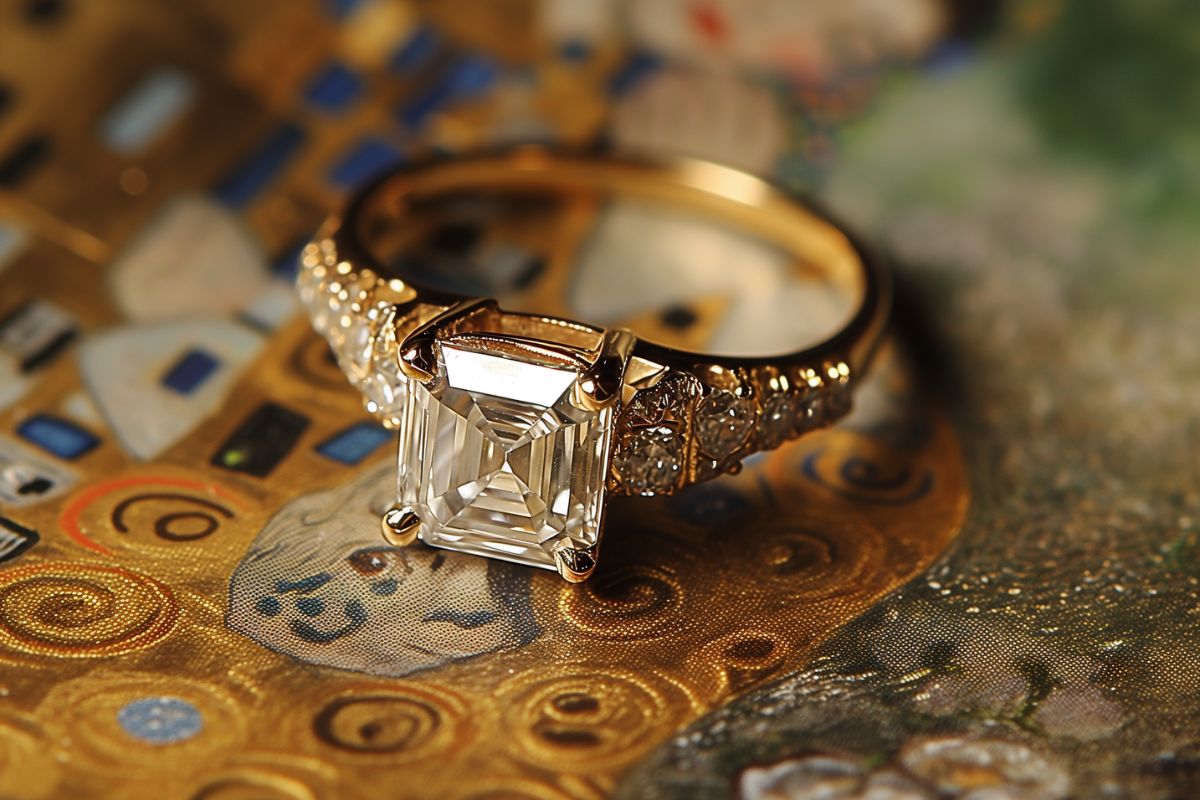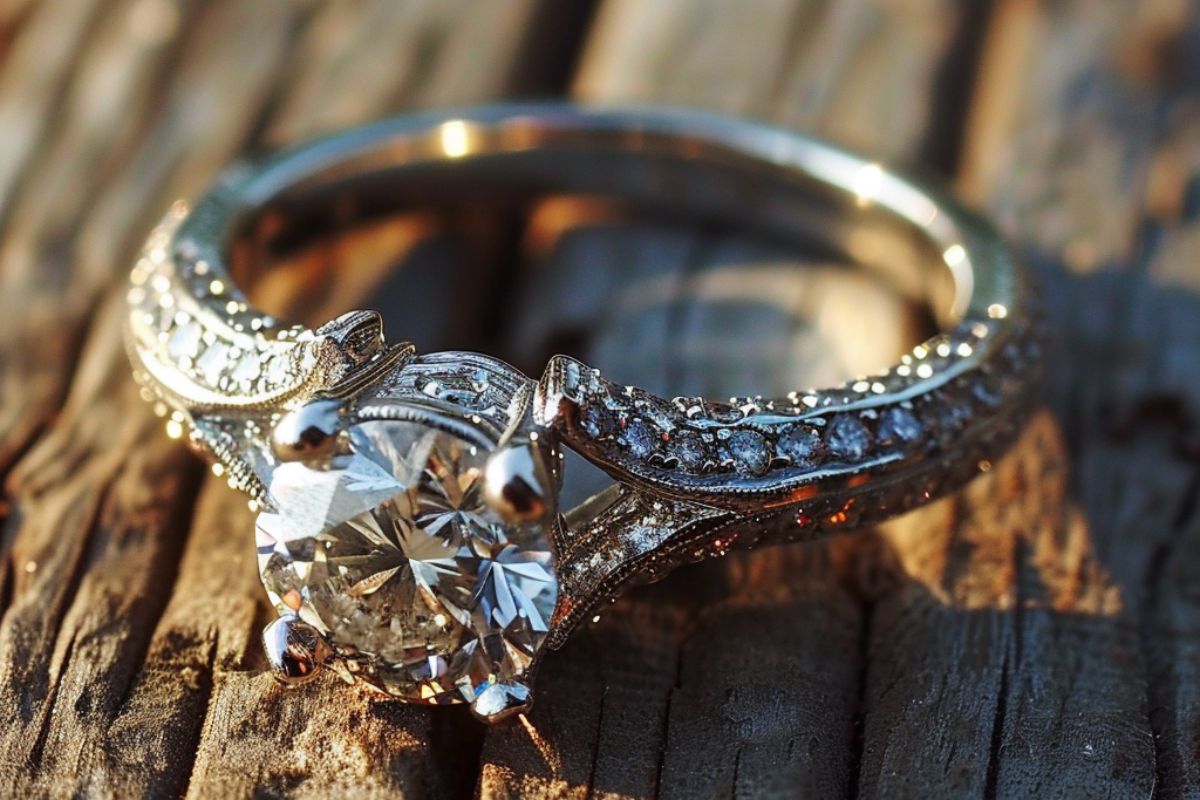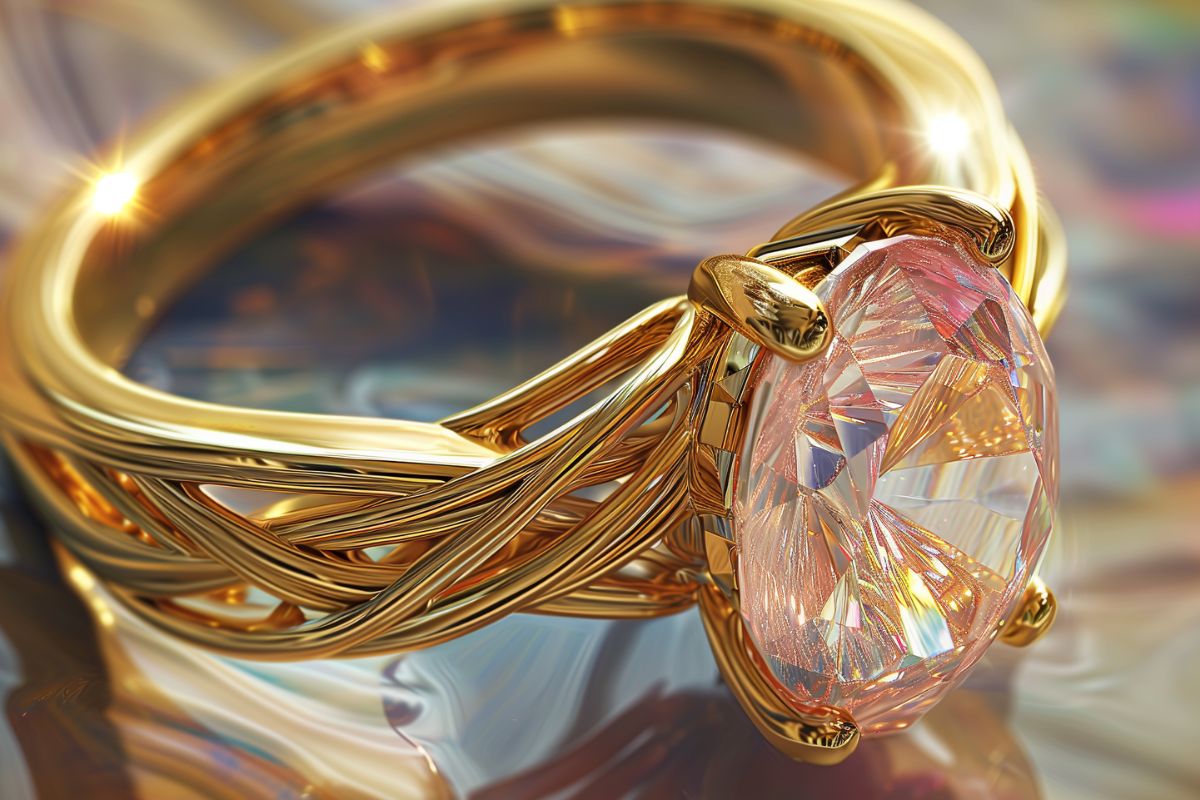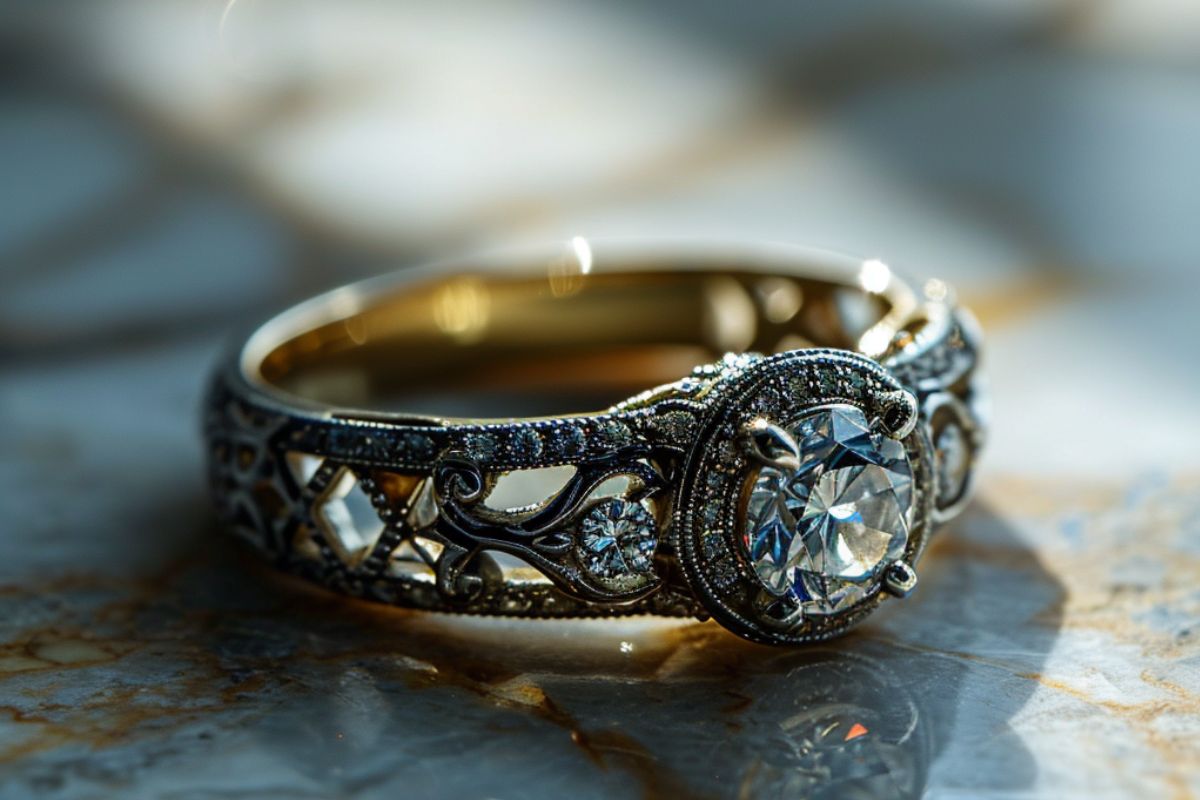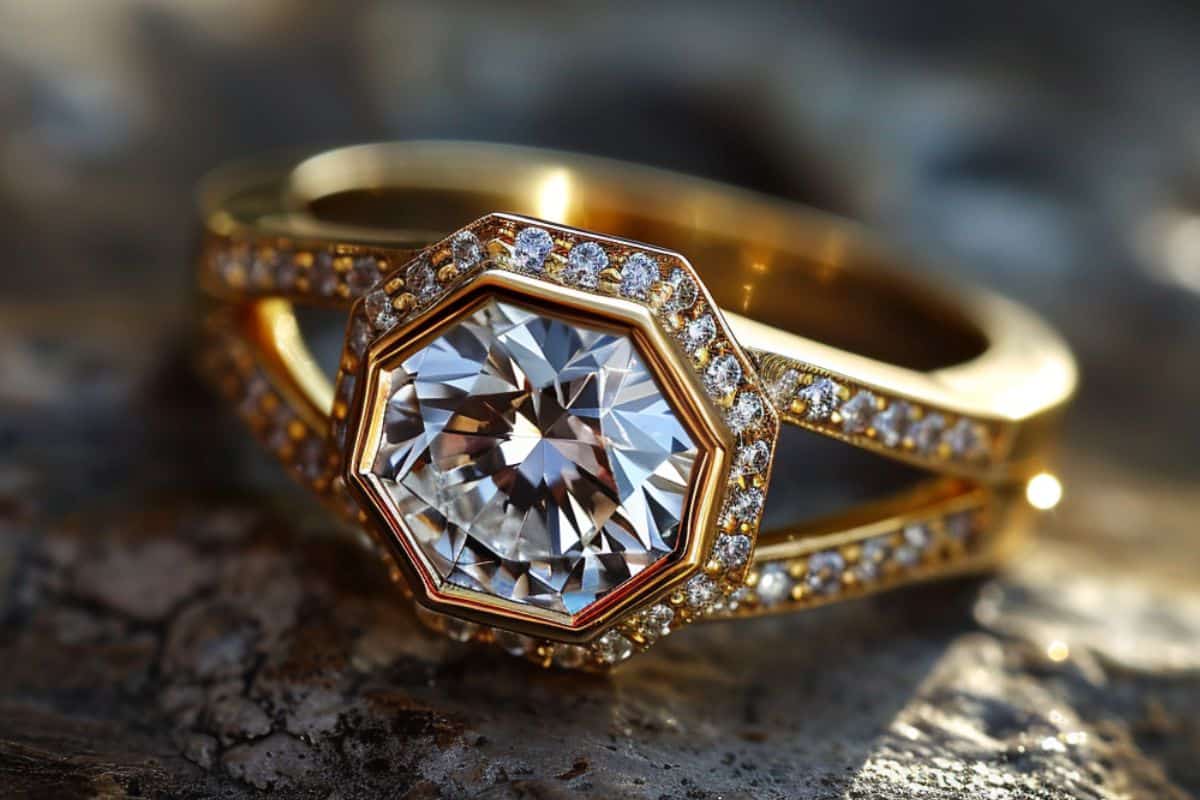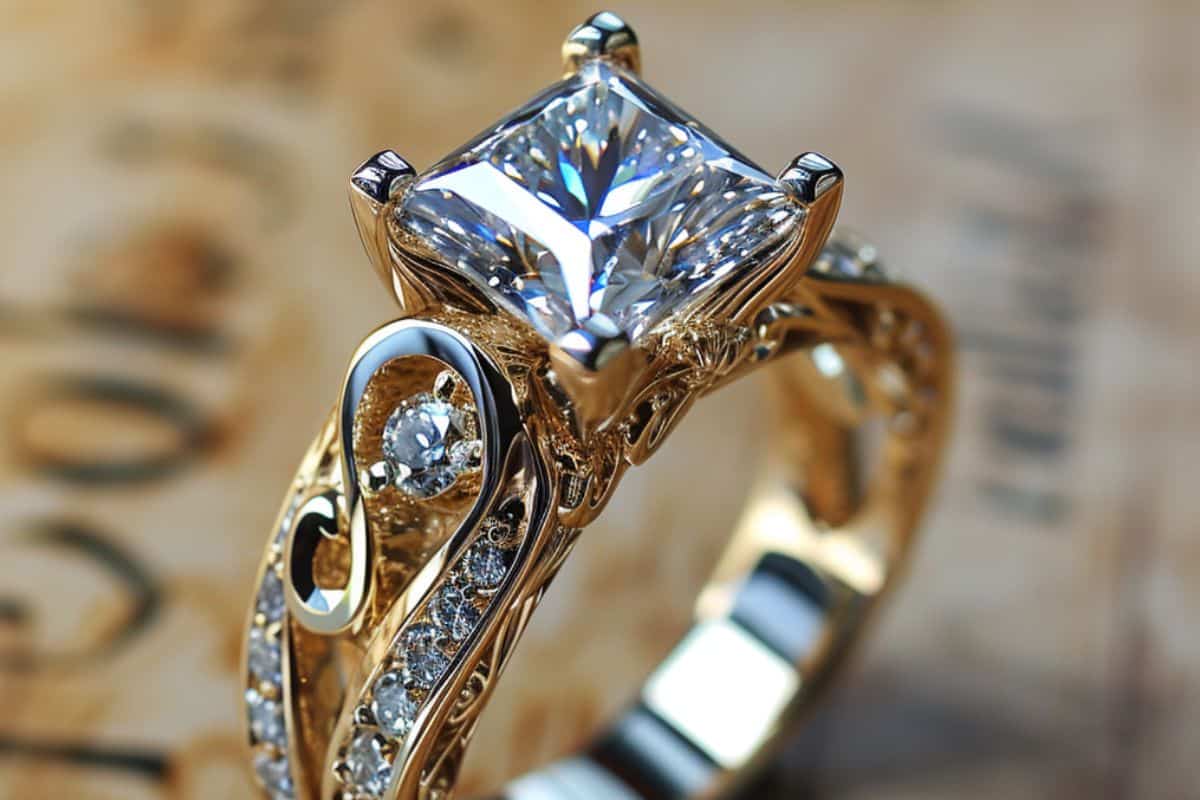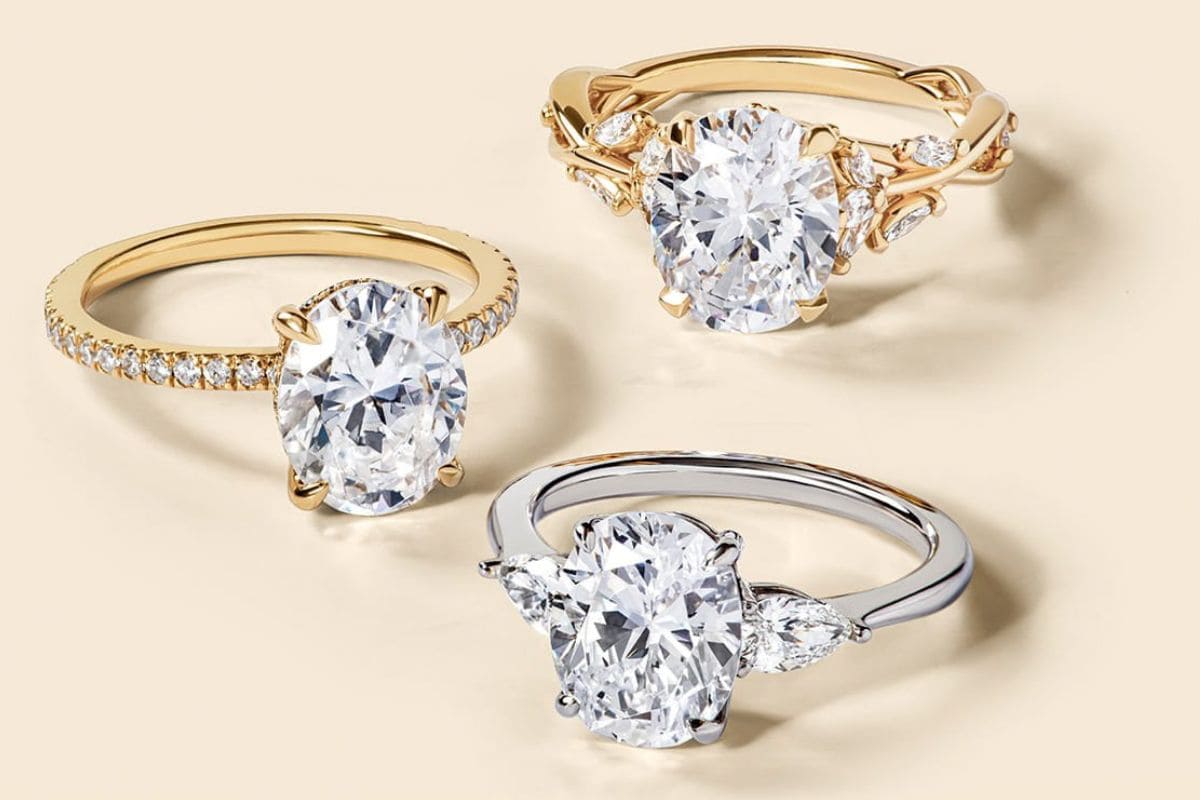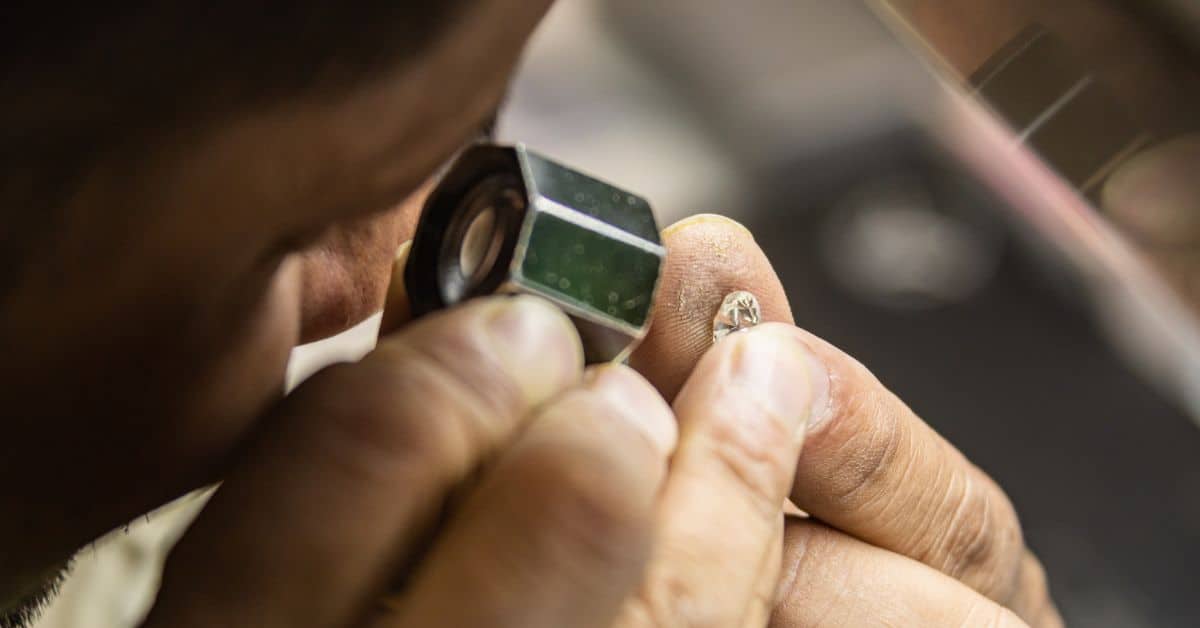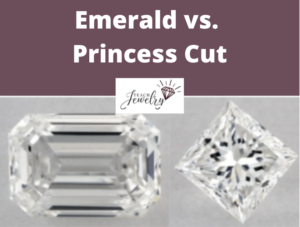
Emerald and princess cuts are fit for engagement rings and other jewelry, but there are several features that differentiate their appearance and performance.
The main difference between emerald and princess cut diamonds is emerald cuts have an elongated, rectangular shape and step-cut facets. Princess cuts are square with brilliant facets. So princess cuts having strong light performance compared to the subtle glow of emerald cuts.
We’ll compare emerald versus princess cut diamonds across eight characteristics, including:
- An overview of each
- Shapes
- Fire and brilliance
- Prices
- Types of settings
Let’s dive into the details.
What are Emerald Cut Diamonds?
Emerald cut diamonds are distinguished by their long, linear facets that run parallel across the table. This feature creates a rectangular surface area that’s larger than most cuts.
Check out this emerald cut in high-resolution, and pay close attention to its facets.
Notice how you can trace the start of one as it stretches across the diamond. This is far more difficult to spot on a round-cut, where the facets are small and shaped like triangles.
Emerald cuts often have 57 facets shaped like a set of steps that begin at the middle of the diamond and work their way outward.
Each of its four corners are beveled with polished edges, resulting in eight sides. In most cases, four are identical in length, and the other four also mimic each other but are much shorter.
Some buyers use them as the center diamond on engagement rings because they cost less than brilliant cuts and offer an alternative to the traditional style.
They’re often compared to a baguette diamond. From a distance, emerald and baguette cuts have similar shapes, but the difference lies in the beveled corners.
Here’s a side-by-side comparison.
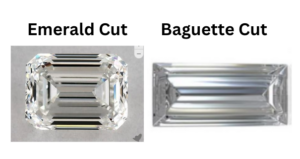
In a baguette cut, those corners are squared off.
What are Princess Cut Diamonds?
Princess cuts are known as “square modified brilliant” diamonds because of their rectangular or squarish shape with pointed corners.
If you view it from the bottom-up, it looks like a pyramid.
Here’s an example of a princess cut viewed from the top-down.
Compare its individual facets to the emerald cut above, and notice how small they are in comparison. It’s difficult to identify where each one begins and ends. Similar to a round cut, they’re shaped like triangles or kites.
Most have 50-58 facets located on the crown and pavilion. Others stretch across its girdle.
Although it’s considered a square diamond like Asscher and radiant cuts, some have a length-to-width ratio of up to 1.05.
If it falls between 1.00-1.05, it’ll resemble a square when viewed with the naked eye.
If the ratio goes above 1.05, it may not exhibit strong light performance because the shape isn’t optimal to collect and return it.
You’ll find princess cuts on top of engagement rings or used as accents that surround the main stone or line the shank.
The latter offers an exceptional design for those who don’t want to fully commit to the cut but still want it featured on the piece.
What are the Differences?
1. Princess Cuts Have Superior Light Performance
Princess cuts have superior light performance, known as fire, brilliance, and scintillation, compared to emerald cuts.
Fire refers to colored flashes of light that radiate from a diamond when it reflects light. Brilliance is the white light.
Together, they create scintillation when it’s twirled. I captured this photo of a princess cut’s fire and brilliance while it was rotating, so you can view both the colored and white light.
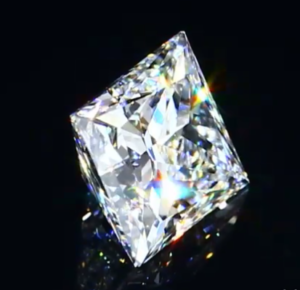
The flashes appear to turn on and off, depending on the angle it receives light.
Emerald cuts have subdued performance in this area because of step-cut facets. They aren’t designed to collect and reflect the maximum amount of the light.
Step-facets are larger than brilliant ones. Instead of a triangular shape, they’re elongated and create a “hall of mirrors” effect.
Brilliant cut facets, on the other hand, have a singular purpose: reflect as much light back to the viewer as possible.
It’s a coveted feature, which is why brilliant cuts like round and princess cut diamonds are often used as the center diamond in an engagement ring.
2. Emerald Cuts Don’t Hide Inclusions
Diamond clarity refers to the extent of inclusions, or flaws, within its facets. They develop during its formation and take many forms, such as:
- Twinning wisps
- Feathers
- Bruises
- Cavities
- Indented naturals
Each can affect the gem’s brilliance, appearance, and durability.
Some cuts hide or reveal inclusions more than others because of the way they reflect light.
Princess cuts hide inclusions more effectively than emerald cuts because of their brilliant cut facets. The white and colored light flashing from the stone can cover the appearance of any number of minor blemishes.
So you can choose a lower clarity grade and still have a diamond that appears flawless without magnification.
For example, this princess cut diamond has an SI1 clarity grade.
Although it has inclusions like black spots, its brilliance will diminish their visibility.
This emerald cut diamond also has an SI1 clarity grade, but the dark speck is more noticeable on the step-cut facets.
For a princess cut diamond between 0.50 and one carat, an SI1 clarity grade means it could be eye-clean, but for emerald cuts, I recommend starting at VS2.
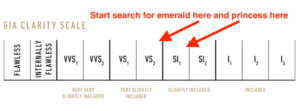
You’ll avoid the premiums for higher clarity grades but can still find one that appears identical to a flawless diamond with the naked eye.
While you can learn the size, type, and position of inclusions by reading the grading report from the Gemological Institute of America (GIA) or another lab, I always recommend viewing it in person or through high-resolution images.
3. Princess Cuts Show Less Color
Many of the same concepts as clarity are true of color. Colorless diamonds are more valuable than ones with yellow or brown tints, when all other qualities are equal.
Brilliant cuts hide these shades more effectively than step-cut facets.
As an example, this princess cut earned an I color grade from the GIA. When viewed closely, it still appears colorless.
This emerald cut also earned an I color grade, but the yellow tint is obvious.
The way the facets are cut result in less brilliance, which exposes its color.
If you want a diamond that appears colorless, save money on a princess cut by choosing one with a lower color grade compared to what you’d need with an emerald cut.
I recommend starting your search for an emerald cut at an H color grade and I for princess cuts.
You’ll save on price compared to ones in the colorless category, but to the naked eye, they’ll appear identical.
4. Emerald Cuts Appear Larger
The size of a diamond is measured in carats, which is a unit of weight equal to 0.2 grams. So two diamonds that are each 0.8 carats are considered the same size.
But if two that weigh the same are placed next to each other, one may look larger depending on the cut.
Emerald cuts often look larger than princess cuts because of their rectangular shape. The carat weight is spread across a larger surface area, which makes the diamond look bigger.
Princess cuts are more condensed and may have a deeper table. More of the weight is hidden beneath the diamond, which reduces the size of its appearance to the naked eye.
The difference in the visible appearance of size is still subtle. You might assume the emerald cut is only 0.05 or 0.10 carats heavier than the princess cut, so I don’t recommend basing your decision on this quality.
You could also choose a slightly larger princess cut to compensate for this shortcoming.
5. Price
If you’re comparing the prices of princess versus emerald cuts, you’ll find princess cuts are more expensive per carat.
This is primarily driven by demand, but some cuts also result in more waste of the rough diamond. Manufacturers charge a higher price to compensate.
The best way to understand the price difference is to compare gems that have the same grades across color, clarity, and carat weight.
I assessed prices for princess and emerald cuts from James Allen, where I bought my wife’s engagement ring, that had the following grades:
- Carat weight: 0.90
- Color: G
- Clarity: VS2
The average price for an emerald cut with these qualities is $3,727, with a range of $2,970-$4,440.
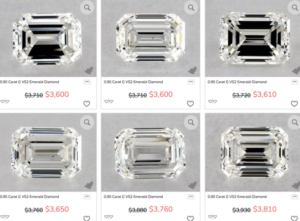
For a princess cut, the average price is $3,856, and the range is $3,180-$4,310.
That’s a three percent premium for princess cuts over emerald cuts.
But as you can see, the exact difference in price depends on several factors, like the quality of its finish and type and size of imperfections.
But either way, you’ll pay less than you would for a round cut. You can use that savings to upgrade its setting or choose improved grades across the four Cs of color, cut, clarity, and carat.
6. Durability
Consider the durability of your diamond. A chip diminishes its appearance and brilliance and could loosen it from its prongs.
Emerald cuts are more durable than princess cuts because of their beveled edges.
One of the most vulnerable piece of a diamond is pointed corners, and princess cuts have four of them.
I’ve highlighted that area on the image below.
If it’s dropped or hit against a hard surface, these are the areas most likely to chip, especially if there are inclusions nearby.
That’s why I recommend choosing a setting that protects these corners but also doesn’t put too much pressure on it.
Emerald cuts are more susceptible to chipping than diamonds with rounded edges, like round, cushion, or oval cuts.
7. Types of Settings
To create the perfect engagement ring, you need a pair a princess or emerald cut with the right setting. Both cuts fit a variety of settings, such as:
- Solitaire
- Halo
- Three-stone
- Hidden accents
- Pave
- Channel
For example, this emerald cut engagement ring from James Allen features a halo setting in 14K white gold, with pave diamonds lining the shank.
The halo emphasizes its rectangular shape while also adding brilliance. Another advantage is this setting mimics the appearance of a larger center diamond.
You can also choose a three-stone setting for princess cuts with tapered baguettes on both sides of the diamond, like this ring.
The rectangular shape of the two baguette cuts complement the square princess cut, while also not allowing the stones to blend together.
It’s a simple setting that doesn’t add significant to the cost of the piece.
Princess cuts are often held in place by V-prongs that wrap around the corner.
It’s an effective way to hold edges in place while also keeping more of the table exposed.
Zoom in on this princess cut with V-prongs and notice how they’re set on each corner.
Then notice how the center diamond is flanked on either side by three channel-set round-cuts.
With emerald cuts, you’ll find the settings feature a variety of styles, from claw prongs to round prongs.
I recommend placing emerald cuts in a setting that features additional diamonds to compensate for its lack of brilliance.
8. Engagement Ring Popularity
Princess cuts are the second most popular cut for engagement rings, representing about 20 percent of sales.
This is a result of the many pros of princess cuts, which include:
- Lower price compared to round cuts
- High amounts of brilliance and fire
- Alternative shape
- Ability to fit a variety of settings
Emerald cuts are the fifth most popular cut, behind round, princess, marquise, and cushion cuts. About three percent of engagement rings feature this cut.
This is despite the many pros of emerald cuts such as:
- They have a lower price per carat than brilliant cuts
- It looks larger than some other cuts, even if they have the same carat weight
- The elongated shape can make your fingers look slimmer
Emerald cuts often rank right above oval and pear cuts in popularity.
But those numbers are for the general public.
I conducted original research on celebrity engagement rings, where I analyzed cuts for 250 celebrities. Emerald cuts were the second most popular in that sample, with 44 of 250 (18 percent.)
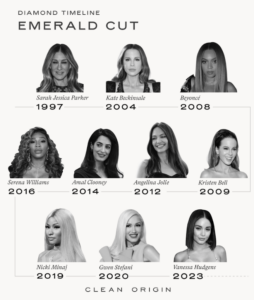
Princess cuts accounted for only three percent. This demonstrates how they appear to be far more popular with the general public.
How to Decide Between Emerald and Princess Cuts
Comparing emerald versus princess cut diamonds involves understanding how they differ across the traits that make up a gem.
Here are some guidelines to help you decide between them.
Opt for an emerald cut if:
- The look of rectangular, step-cut facets are appealing
- The lack of brilliance compared to princess cuts isn’t an important factor for you
- You’ll consider adding other diamonds to the ring to improve its sparkle
- You want to pay less per carat than you would for a brilliant cut
A princess cut may be right for you if:
- You want an alternative to a round cut that doesn’t sacrifice too much brilliance and fire
- You’ll choose a setting that protects its vulnerable corners
- It’s important the diamond hides inclusions and yellow tints when viewed with the naked eye
By matching an emerald or princess cut diamond with a unique setting, you’ll create the right ring for you.

Jacob Clarke
Jacob Clarke is the founder of TeachJewelry.com.
He earned an Applied Jewelry Professional Diploma from the Gemological Institute of America (GIA) and now brings you essential information about diamonds, settings, and more.
Jacob has consulted with leading jewelry brands, and his work has been cited in Clean Origin, Diamond Nexus and industry publications.
He's also a member of the International Gem Society.
He enjoys discussing jewelry with readers, so contact him with any questions at jacob.clarke@teachjewelry.com.
